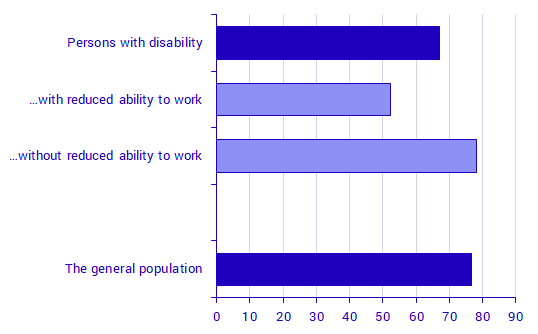The labour market situation for persons with disabilities, 2020
Proportion of employed persons smaller among persons with disabilities
Statistical news from Statistics Sweden 2021-03-31 9.30
The proportion of employed persons is smaller among persons with disabilities than in the population as a whole. In 2020, the employment rate among persons with disabilities was 67 percent, compared with 77 percent in the population as a whole.
On behalf of the Government, Statistics Sweden has carried out a survey on the labour market situation for persons with disabilities. In the survey, 16 percent of the population aged 16–64 years stated that they had a disability. Among those, 42 percent consider that their ability to work is very reduced or partially reduced.
The proportion of employed persons is smaller among persons with disabilities than in the population as a whole. In 2020, the employment rate among persons with disabilities was 67 percent. Among people who have a disability that involves a reduced ability to work, the unemployment rate was 52 percent. The corresponding percentage among the total population was 77 percent.

In 2020, the unemployment rate was 9 percent, both among persons with disabilities and the total population. However, the proportion of unemployed persons among persons with a disability that involves a reduced ability to work, the unemployment was higher, at 17 percent.
Proportion of persons with disabilities working full-time was smaller
The proportion of persons with disabilities working full-time was smaller than in the total population. Among employed persons with disabilities, 70 percent work full-time. Among persons with disabilities that involved reduced ability to work, this figure was 58 percent. The corresponding proportion among the total population was 77 percent.
The proportion of people working full-time is lower among women than among men. This was the case both among persons with disabilities and among the total population.
Definitions and explanations
The survey includes people aged 16–64 years who are registered in the population in Sweden. A question about disability is asked in direct connection with the Labour Force Survey (LFS). People who state that they have a disability are asked whether their disability has led to a reduced ability to work.
The 2020 survey was carried out using a different approach than in previous years. This means it is not possible to compare results for the group with reduced ability to work for 2020 and previous years. The results for the whole group of persons with disabilities, on the other hand, is comparable over time.
The information for the total population presented here differs from the official statistics on the 2020 LFS. This is in part due to a difference in the collection period, and in part because the estimates are only based on the sample for this survey and not on the whole LFS sample.
Persons with disabilities comprise those who answered “Yes” to the following question:
In this survey, disability refers to a person having impaired vision or hearing, speech or voice problems, motor disability, allergies or some form of mental disability. Disability can also refer to a person having diabetes, heart and lung problems, gastrointestinal disease, psoriasis, epilepsy, dyslexia or something similar. Based on this definition, are you classified as having a disability?
Publication
Feel free to use the facts from this statistical news but remember to state Source: Statistics Sweden.
